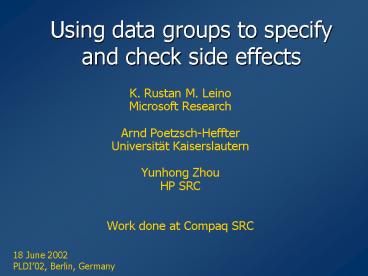Using data groups to specify and check side effects - PowerPoint PPT Presentation
1 / 17
Title:
Using data groups to specify and check side effects
Description:
a core object-oriented language (oolong ) pivot uniqueness and owner exclusion restrictions ... translation from oolong to verification conditions. Related work ... – PowerPoint PPT presentation
Number of Views:32
Avg rating:3.0/5.0
Title: Using data groups to specify and check side effects
1
Using data groups to specify and check side
effects
- K. Rustan M. Leino
- Microsoft Research
- Arnd Poetzsch-Heffter
- Universität Kaiserslautern
- Yunhong Zhou
- HP SRC
- Work done at Compaq SRC
18 June 2002PLDI02, Berlin, Germany
2
Context
Staticprogramchecker
Pieces of a
Warningmessages
Program
Modular checking
3
- Modular checking
- Dont assume availability of
- implementations of called methods
- all of the programs variables
- Modular soundness
- Checking is sound for any extension of the
program
4
Reasoning about a call
method m(Queue q, T t) t.x new
File(input.txt) q.Enqueue(t) char ch
t.x.ReadChar()
t.x null
null dereference ?
Must know what the call can modify!
5
Modifies clause
method p(x, y) modifies M
Grants the implementations of pthe license to
modify M
6
Information hiding
Queue
q
head
17
method Enqueue(x) modifies ???
Buffer
size
8
capacity
public
32
buf
method Enlarge() modifies capacity,
private
7
Data groups
Queue
q
A data group represents a set of variables and
other (nested) data groups
group contents
head
17
method Enqueue(x) modifies contents
method Enqueue(x) modifies ???
Buffer
size
The license to modify a group implies the license
to modify the members of the group
8
capacity
public
32
buf
method Enlarge() modifies capacity,
private
8
Source code
Queue
buf
pivot field
class Queue public group contents public
void Enqueue(object x) modifies contents
Note direction of declarations
Buffer
capacity
head ? contents size ? contents
private int head in contents private int size
in contents
private Buffer buf maps capacity into contents
buf.capacity ? contents
9
Summary so far
- modular checking
- modifies clauses
- information hiding
- data groups!
- next 2 problems and proposed solutions
10
Problem 0
group contents
Queue
method Enqueue(x) modifies contents
Queue q new Queue()
head
method Buffer m() modifies
Buffer b q.m()
size
int c b.capacity
buf
q.Enqueue(5)
assert c b.capacity
q
Buffer
method Buffer m() return buf
capacity
b
11
Solution 0 Pivot uniqueness restriction
- Make pivot fields unique
Queue
Buffer
capacity
group contents
buf
field buf maps capacity into contents
- except permit aliasing with parameters
method Enqueue(object x) if (size
buf.capacity) buf.Enlarge()
- Restrict parameters likewise
12
Problem 1
Queue
new Queue()
Queue q
group contents
head
method p( , )
q.m()
Buffer b
size
buf
q
Buffer
class Queue p(this, buf)
capacity
b
13
Solution 1 Owner exclusion restriction
For any pivot field field buf maps capacity
into contents and method method m(, T x,
) modifies , E.contents, add to m the
following precondition E.buf ! x
14
Whats in the paper
- Sound formalization
- a core object-oriented language (oolong )
- pivot uniqueness and owner exclusion restrictions
- translation from oolong to verification conditions
15
Related work
- Modifies clauses
- Larch, CLU, frame problem,
- Effect systems, effect inference,
- Abstraction
- Theory work on Simula Hoare 1972
- Aspect Jackson 1995
- ESC/Modula-3 specifications Leino Nelson 1998
- Alias confinement
- Islands, Balloons, Flexible alias protection,
- Linear types, Cqual, capabilities, Vault,
- Alias burying Boyland 2001
- Universe types Müller Poetzsch-Heffter 2002
16
Summary of approach
- modifies clauses
- data groups
- in, maps into
- alias-confinement restrictions
- pivot uniqueness
- owner exclusion
17
Conclusion
- Knowing side effects has many applications
- Specifying and checking side effects in modular
setting is a difficult problem - Data groups plus alias-confinement restrictions
provide a solution - Sound formalization (oolong )
- Implemented checker (oolong )
- Current work build checker for C (with Viktor
Kuncak) - Needs extension to arrays, ?































